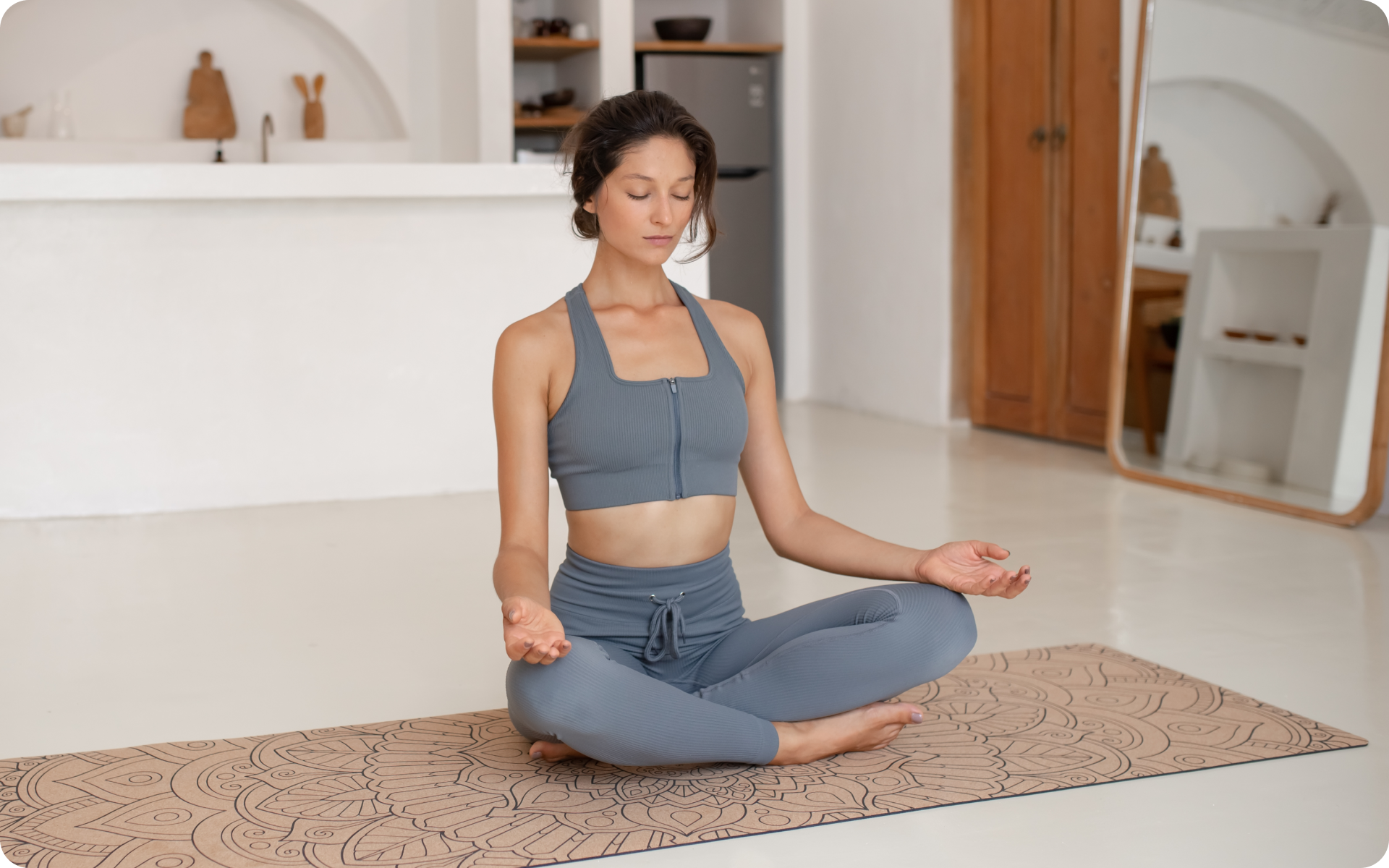Following prolonged or significant stress, our bodies enter a state of heightened alertness, making it difficult to manage our emotions and reactions. This state can be disconcerting and uncomfortable and can also make the navigation of our daily lives more difficult.
But what if there was a way of managing these feelings/emotions and bringing ourselves back to a place of calm and centeredness? Somatic grounding is a therapeutic technique that uses the inherent body awareness to manage and mitigate the effects of experiencing a distressing event.
It encourages us to tap into the internal sensations in our bodies and use them as a guide for understanding and processing our emotional responses.
By connecting with our physical selves, we can begin deescalating the feelings and bring ourselves back to a state of equilibrium and peace.
Somatic exercises can be incredibly empowering and offer a proactive way of handling the stresses and strains of life. Here is everything you need to know.
Running a never-ending rat race, shoving trauma further and further away, falling into self-harming thought patterns, living life that’s eclipsed by constant anxiety and fear – this is what an average person goes through every day. Not addressing it will only pull you deeper into a downward spiral. BetterMe: Meditation & Sleep app will help you gain a new perspective on life and help you regain that long-lost internal balance!
What Is Somatic Grounding?
Somatic grounding is a therapeutic technique involving the use of the physical sensations of the body to foster a sense of emotional stability and anchor oneself to the present moment.. It stems from the field of Somatic Experiencing, which is an approach to therapy targeting the physical effects of highly upsetting events (5).
Here are some of the key aspects of somatic grounding:
Mind-Body Connection
Somatic grounding fosters an understanding of the interconnectedness of the mind and body. It encourages individuals to recognize that emotions manifest as physical sensations and vice versa. Cultivating awareness of bodily sensations, such as tension, relaxation, warmth, or discomfor helps individuals stay present in the moment and understand their body’s responses to different situations.
Self-Regulation
Somatic grounding helps individuals regulate their emotional responses by using bodily sensations as indicators of emotional states. Recognizing physical cues allows for better emotional management and the ability to respond rather than react impulsively.
Grounding Exercises
These can vary, but generally involve creating a sense of stability and connecting oneself to the present moment This can include running cold water over your hands to feel the sensations, moving your body in ways that feel comfortable while being connected to the earth, or simply being aware of your breath which can help regulate the nervous system, promote relaxation, and reduce stress.
Dual Awareness
This refers to the ability to be aware of two things at once. In the context of somatic grounding,this can mean an awareness of a physical sensation while acknowledging an emotional state.
Self-Care
The practice of somatic grounding is a type of self-care and helps individuals reconnect with their bodies, manage stress, and cultivate a sense of safety and well-being.
Essentially, somatic grounding is about harnessing the wisdom of the body and navigating emotional experiences and promoting overall well-being. It is a powerful, proactive technique that anyone can practice, regardless of their experience with a distressful event or managing stress.
While there is often an association between grounding techniques and mental health, they also support other areas of our lives, including physical health or creative endeavors (3).
While there are no specific somatic exercises for weight loss, some associated practices such mindful eating, yoga, or breathwork, can help reduce emotional eating while cultivating an awareness of the needs of the body.
Similarly, there are no specific grounding techniques for sleep, but practices such as progressive muscle relaxation or guided imagery, can help foster a peaceful, relaxed state, encouraging restful sleep.
Read more: Mental Health And Sports: The Do’s, Don’ts And The In Between.
Do Somatic Exercises Release Negative Emotions?
Yes, somatic exercises can help release unresolved emotions (4).
Somatic therapy is a body-centered therapeutic approach that focuses on the mind-body connection as a means of healing and managing unresolved emotions stored in the body. They do not not simply reside in our minds and can be held in our bodies, often manifesting itself as physical tension or discomfort.
Somatic exercises for releasing pent-up emotions linked to experiencing a upsetting event, use a bottom-up approach to recovery, which means they use the body as an entry point to explore sensations and related thoughts and feelings.
These exercises can include breathing exercises, dance, mindfulness, and other body movement techniques. The goal of these exercises is focusing attention on bodily sensations to uncover and release areas of tension.
This practice is based on the theory that the body and mind are not separate and are intimately connected. Therefore, healing the body can result in emotional healing.
While these exercises can serve as an effective part of a comprehensive recovery plan, all experiences are unique and that which works for one person may not work for another. It is recommended that you seek professional guidance when dealing with unresolved emotions.
What Are The Three Types Of Grounding Techniques?
Grounding techniques are strategies that can help a person manage their emotions by reconnecting with the present moment and their physical world. The following are three types of grounding techniques:
Physical Grounding Techniques
These involve the use of their senses (touch, taste, sight, sound, smell) to anchor yourself in the present.
Examples include breathwork, feet on the floor exercise, holding an ice cube, eating something with a strong taste such as a lemon or peppermint, focusing on the details of an object in your sight, listening to soothing music, or smelling a favorite scent.
Mental Grounding Techniques
These techniques engage your mind and help divert thoughts away from distressing feelings into more realistic or positive ones.
Examples include counting backwards from 100, mindfulness, meditation, recalling kindness, using affirmation words naming objects around you, describing your current activity in detail, or completing a crossword or Sudoku puzzle.
Soothing Grounding Techniques
These techniques help calm the mind by focusing on positive feelings and thoughts. They can involve thinking of your favorite place and visualizing every detail, repeating a comforting phrase, listening to music, creative artwork, or picturing your loved ones.
What Is The 5 Senses Grounding Technique?
The 5-4-3-2-1senses grounding technique is a mindfulness exercise that is designed to help reduce feelings of stress. i. This technique utilizes the five senses to focus on the present moment, thereby bringing about a sense of calm.
Here is how it works (1):
Five
Acknowledge FIVE things you can see around you. This can be anything in your surroundings, such as a tree outside the window, a photograph on the wall, or a cup on your desk.
Four
Acknowledge FOUR things you can touch around you. This can include tour clothing fabric, the surface of your desk, the coolness of a glass of water, or the warmth of the sun as it shines through the window.
Three
Acknowledge THREE things you can hear. This can be the sound of traffic, birds chirping, or the hum of your computer.
Two
Acknowledge TWO things you can smell. If you cannot immediately identify two smells, you could move to another position or take a moment and smell your coffee, a flower, or another nearby object with a scent.
One
Acknowledge ONE thing you can taste. This can be the sip of a drink or the current taste in your mouth.
If you wish to reach into the deep crevices of your mind, take yourself out of the mental loop, regain balance, infuse yourself with optimism, and cultivate compassion – BetterMe: Meditation & Sleep app is exactly what you need!
What Are Examples Of Somatic Exercises For Grounding?
Somatic exercises for grounding vary and can be tailored to the needs and comfort levels of an individual. Their aim is to reconnect the individual with their body and the present moment, which helps them manage distressing emotions. Here are some examples:
Standing Awareness Exercise
- Stand normally, letting your hands hang by your sides. You don’t need to attain perfect posture
- Close your eyes as you perform a full body mental scan
- Take note of how you’re feeling, while keeping your eyes closed
- Maintain mindfulness through out
Connecting To The Earth
This exercise encourages a sense of embodiment and connectedness to the natural world around us, which enhances feelings of groundedness.
- Take off your shoes and socks.
- Stand or sit on a natural surface such as grass, sand, or soil.
- Close your eyes and visualize the energy that flows between you and the earth.
- Remain in this state for several minutes, breathing deeply.
Healing Hands
Place your hand on the part of your body that has experienced a shift or change, and breathe deeply. If it is an overall feeling, place your hand on your heart or stomach.
- Identify where your body feels tense or uncomfortable.
- Place your hand over this area.
- Breathe deeply and imagine your breath going to this area.
- Hold this position until a shift in sensation is noticed.
Grounding and Centering
Techniques may involve the visualization of roots growing from your feet into the ground, or focusing on the sensation of your feet touching the floor.
- Stand or sit with your feet flat. Taking your shoes off for this exercise may make you feel more comfortable.
- Take a few deep breaths, focusing on the sensation of your feet connecting with the earth.
- Visualize roots growing from your feet into the ground, anchoring you to be connected with the earth
- Start shifting your weight from left to right, swaying as a tree. Shift your weight from front to the back.
- As you shift your weight, slowly bring your swaying to a standstill. Bring your awareness to your center of gravity, located in the upper pelvic area and below the navel.
- Bring your hands on top of your lower belly and feel your center.
- Feel the connection between your body and the earth.
- Focus on this sensation for a moment.
Tactile Activation
It is the process of stimulating the sense of touch to engage one’s body and regulate the nervous system by self-to-self physical contact.
- Start by rubbing your hands together.
- When your hands are warm, place them on different parts of the body.
- Notice the sensations under your hands.
- Repeat the rubbing process and move your hands to different parts of the body as required.
Self-Hug
Cross both arms and hold your shoulder, bending your head toward the heart. This can promote feelings of safety and groundedness.
- Cross your arms over your chest where you right hand is over your chest to feel your heartbeat
- Reach for your left arm over your right shoulder, gently squeezing yourself.
- Lower your head toward your chest.
- Hold this position and breathe deeply.
Tensing And Relaxing Muscles
Tensing and relaxing different muscle groups can help bring awareness back to the body and the present moment.
- Start with your toes and work up to the head.
- Tense each muscle group for several seconds, then release.
- Notice the difference in sensation between tension and relaxation.
- Continue this process for each muscle group.
Read more: How To Lower Cortisol: Decrease Your Stress Levels And Lose Weight.
FAQ
What Is Somatic Meditation?
Somatic meditation is a practice focusing on the internal, physical sensations of the body as a pathway to mindfulness and healing.
Unlike traditional meditation techniques that encourage detachment from physical sensations, somatic meditation encourages active awareness and engagement with the sensory experiences of the body.
The aim is to train the brain to focus on how the body feels,enhancing mindfulness, facilitating rational responses to triggers, and helping release tension and trapped emotions.
What Is Sensory Grounding?
Sensory grounding is a therapeutic technique that is used as a means of coping with distressing or overwhelming emotions or thoughts.
It involves the use of the five senses to bring your focus back to the present moment. This can involve focusing on the details of an object you can see, listening to specific sounds, touching or holding an object, tasting something that has a strong flavor, or smelling a particular scent.
These techniques work by redirecting your attention from distressing thoughts or feelings and grounding you in the physical world around you.
What Is The Rule Of 3 Grounding?
The rule of 3 is a simple grounding technique used in somatic therapy for managing disstressful feelings. It involves identifying and focusing on three things you can see, three you can hear, and three you can touch.
This method helps divert attention away from distressing thoughts or feelings and refocuses the mind on your immediate surroundings, helping reduce overwhelming emotions and bringing you back to the present moment.
The Bottom Line
Harness the power of your mind-body connection with these 11 somatic grounding exercises. Learn to navigate and manage your emotions effectively, and foster greater self-awareness, resilience, and emotional balance.
DISCLAIMER:
This article is intended for general informational purposes only and does not serve to address individual circumstances. It is not a substitute for professional advice or help and should not be relied on for making any kind of decision-making. Any action taken as a direct or indirect result of the information in this article is entirely at your own risk and is your sole responsibility.
BetterMe, its content staff, and its medical advisors accept no responsibility for inaccuracies, errors, misstatements, inconsistencies, or omissions and specifically disclaim any liability, loss or risk, personal, professional or otherwise, which may be incurred as a consequence, directly or indirectly, of the use and/or application of any content.
You should always seek the advice of your physician or other qualified health provider with any questions you may have regarding a medical condition or your specific situation. Never disregard professional medical advice or delay seeking it because of BetterMe content. If you suspect or think you may have a medical emergency, call your doctor.
SOURCES:
- 5-4-3-2-1 Coping Technique for Anxiety (2018, rochester.edu)
- Benefits of Somatic Therapy (2022, integrativelifecenter.com)
- Grounding the Connection Between Psyche and Soma: Creating a Reliable Observation Tool for Grounding Assessment in an Adult Population (2021, nih.gov) a
- Somatic Exercises to Improve Your Mental Health (2023, charliehealth.com) b
- Somatic experiencing – effectiveness and key factors of a body-oriented trauma therapy: a scoping literature review (2021, nih.gov)











